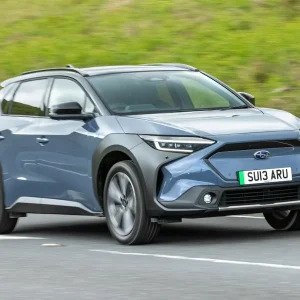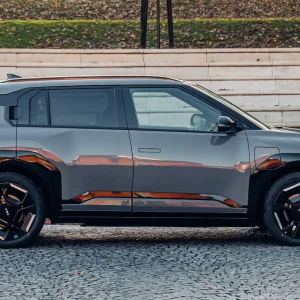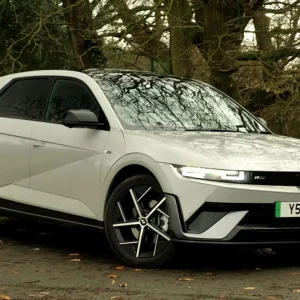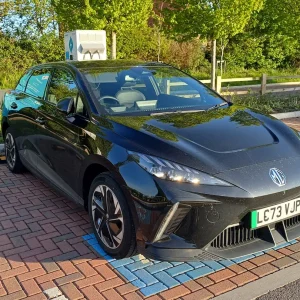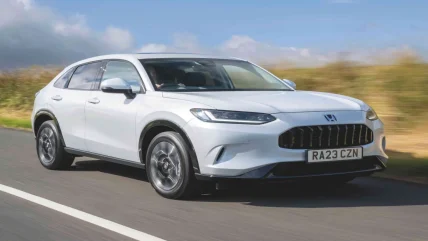
You’d be hard-pressed to find a breed of modern vehicle that doesn’t have some sort of electrical powertrain wizardry under the bonnet. Even a lot of “regular petrol” cars have a small mild hybrid system ticking away beneath the surface. But not all efficiency-boosting hybrid and electric systems are created equally. In fact, some are downright disappointing.
Imagine our surprise then when we jumped inside Honda’s latest hybrid SUV, and found that the hybrid system does exactly what it says it should. Bonkers, right?
The Honda ZR-V e-HEV sits on the same platform as the latest generation of Honda Civic, meaning it has solid, agile underpinnings and hybrid compatibility at its core. The jury is still out on its looks, but on paper, it makes total sense. The ZR-V e-HEV shares the Civic’s hybrid set-up, with a 2.0-litre petrol engine, two electric motors, a small battery, and an overall power output of around 180hp.
The reason this hybrid set-up is worth shouting about is because it gives you the impression of all-electric driving in the vast majority of driving situations, effectively giving you EV characteristics without the accompanying range anxiety. This system works by using the petrol engine as a generator to charge the on-board battery, which then powers the electric motors and moves the wheels. As you increase your speed, the hybrid system smoothly and quietly transitions from full-electric to hybrid mode. Only under very harsh acceleration will the petrol engine bypass this and directly power the wheels.
With this system in place, the ZR-V e-HEV skirts the dreaded hybrid drone from the engine, which typically kicks in around 10mph and above in other hybrids. For those wanting a hybrid system that feels “green” at all times, this is it. The boffins at Honda have also engineered false gear changes with the single-speed automatic gearbox that’s present, further enhancing the smooth power delivery.
And aside from its hybrid character, the ZR-V offers a well-rounded drive, with fairly weighty, engaging steering, a balanced suspension and a general sense of ease.
So, do these driving characteristics mean the ZR-V e-HEV boasts superior hybrid efficiency that trumps its rivals? No, actually. All things considered, the ZR-V e-HEV’s fuel economy figures are fairly average when compared to its rivals. You can expect to get between 45-50mpg on a mixture of urban and motorway journeys.
Elsewhere, the ZR-V has lots of other similarities to its Civic hatchback sibling. The interior offers a minimalistic, clean-cut, smart design, with flourishes of padded leather dotted about, plush seats and a slick digital instrument cluster. While build quality is lacking in a few specific areas, overall, the ZR-V’s interior offers up a surprising amount of opulence. Equipment across the range is impressive too, with entry-level Elegant models getting a reversing camera, sat-nav, adaptive cruise control and heated front seats.
The ZR-V’s practicality is a bit of a mixed bag. While there’s enough leg room for rear passengers, and moving about the rear seats is easy to do thanks to the flat floor, head room is encumbered slightly by the panoramic roof (fitted on flagship Advance models) which means six-foot passengers will struggle. The rear seats also sit at a slight angle, meaning your knees sit quite high, which may become uncomfortable on long journeys.
The boot is a little more finessed, with everything but its actual capacity being on the money. It has a no-nonsense square shape, a low load lip, a stowaway parcel shelf, and the rear seats – which fold completely flat – can be flopped forward from the boot itself. For those specifically after SUV flexibility however, its 380-litre capacity is a little underwhelming.
Honda ZR-V 2.0 eHEV Advance
P11D: £42,595
Residual value: 45.5%
Depreciation: £22,355
Fuel: £8,678
Service, maintenance and repair: £1,577
Cost per mile: 54.35p
Fuel consumption: 48.7mpg
CO2 (BIK %): 132g/km (21%)
BIK 20/40% a month: £220/£440
Luggage capacity: 380 litres
Engine size/power: 1,995cc/184hp

